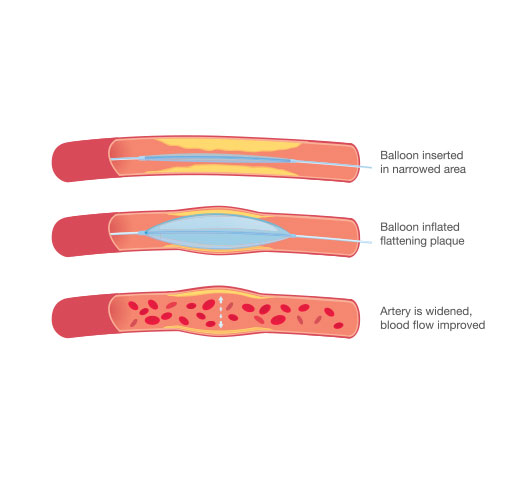-
Products
-
- Featured Products
- Supraflex Cruz
-
- Professionals
- Patients & Caregivers
- Investors
- About SMT
Main navigation
Why is it performed?
Balloon angioplasty is performed to relieve symptoms of blocked arteries, most commonly chest pain and shortness of breath. This procedure may also be done to immediately re-open blocked blood vessels and stop damage to the heart muscle before it dies.

- The procedure is performed through either the groin area or wrist. The operator will inject anaesthesia to numb the groin/wrist area and then insert a catheter. A catheter is a small thin and hollow tube that is inserted into blood vessels.
- With help of an imaging tool, the operator guides the catheter into the blocked blood vessel. Next, a very thin wire called a guide wire is passed through the catheter across the blockage. This guide wire guides a balloon catheter with a thin inflatable balloon towards the blockage.
- The balloon is inflated. When it is inflated it pushes the plaque towards the side, against the walls of the blood vessel. This stretches the artery to its normal size and restores normal blood flow. The inflation of the balloon can be performed more than once.
- The balloon is then deflated and removed from the blood vessel along with the guide wire and catheter. Normal blood flow is achieved.
Although balloon angioplasty is a minimally invasive procedure, it does carry some risks.
- The most common risks are:
- Re-narrowing of the blood vessel
- Formation of blood clots
- Bleeding
- The less common risks are:
- Heart attack
- Coronary artery damage
- Kidney problems
- Stroke
- Abnormal heart rhythms
After the procedure is performed, the nurse/operator will apply pressure to the puncture site to make sure there is no internal bleeding. If the procedure is to be performed through the leg you will be advised not to walk soon after the procedure. You will be asked to rest on your back for several hours whilst the nurse/operator observe that there is no bleeding from the puncture site. In some cases, you may be required to spend the night at the hospital. There are chances that blood clots may form inside the operated region within the blood vessel and so you will be prescribed medicines to prevent this. You will also be advised not to lift heavy things and to avoid carrying out vigorous physical activities. Call your doctor if you experience:
- Bleeding/swelling at the puncture site
- Pain/discomfort at the puncture site
- Signs of infection such as fever
- Chest pain
- Shortness of breath
- Weakness
After the procedure, lifestyle habits should be modified, smoking should be stopped, blood sugar, blood pressure and cholesterol levels should be maintained. A healthy diet should be followed. Regular exercise should be carried out. Medicines should be taken as prescribed. If symptoms reappear, one should not hesitate to contact the doctor!


